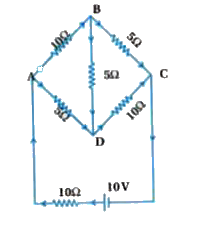Hence ohtaln the work done in bringing charge of 2×10−9 C . From infinity to the point P. Does the answer depend on the path along which the charge is brought ? Solution in Gujrati
Let V(P) = and V(∞)=0
∴V(P)−V(∞)=ΔV=V=4×104V
Now the work done in bringing a charge of 2×109 C from infinity to the point P,
W= q ΔV=qV
=2×10−9×4×104
∴W=8×10−5J
No work done will be path independent.
Any arbitrary infinitesimal path can be resolved into two perpendicular displacements.
(1) Along parallel to displacement →r and
(2) Along perpendicular to displacement →r.
But work done corresponding to perpendicular component will be zero.
Topper's Solved these Questions
- ELECTROSTATIC POTENTIAL AND CAPACITANCEBOOK - KUMAR PRAKASHANCHAPTER - ELECTROSTATIC POTENTIAL AND CAPACITANCEEXERCISE - Section B ( Numerical From Textual Exercise )
46 Videos
- ELECTROSTATIC POTENTIAL AND CAPACITANCEBOOK - KUMAR PRAKASHANCHAPTER - ELECTROSTATIC POTENTIAL AND CAPACITANCEEXERCISE - Section B ( Numerical From DARPAN. Based on Textbook )
19 Videos
- ELECTROSTATIC POTENTIAL AND CAPACITANCEBOOK - KUMAR PRAKASHANCHAPTER - ELECTROSTATIC POTENTIAL AND CAPACITANCEEXERCISE - ( Section -A) Try Yourself
50 Videos
- ELECTROMAGNETIC WAVESBOOK - KUMAR PRAKASHANCHAPTER - ELECTROMAGNETIC WAVESEXERCISE - BOARD.S QUESTION PAPER MARCH - 2020 (PART - B) SECTION - C
5 Videos
- MAGNETISM AND MATTERBOOK - KUMAR PRAKASHANCHAPTER - MAGNETISM AND MATTEREXERCISE - SECTION D Multiple Choice Questions (MCQs) (MCQs asked in Competitive Exams) MCQs asked in Board Exam and GUJCET
7 Videos
Similar Questions
Two charge 5×10−8C and −3×10−8 C are located 16 cm apart. At what point(s) on the line joining the two charges is the electric potential zero ? Take the potential at infinity to be zero.
View SolutionAn electric field is represented by →E=Axˆi where A = 10Vm2 . Find the potential of the origin with respect to the point (10,20) m.
View SolutionWhat are conservative force , non - conservative force , conservative field and non - conservative field ?
View SolutionDetermine the current in each branch of the given network.

View SolutionAt a place on earth the vertical component of earth's magnetic field is √3 times its horizontal component. The angle of dip at this place is …...
View Solution(a) Calculate the potential at a point P due to a charge of 4xx10^(-7) C located 9 cm away. (b) Hence obtain the work done in bringing a charge of 2xx10^(-9) C from infinity to the point P. Does the answer depend on the path along which the charge is brought ?
View SolutionA charges of 50×10−9C is placed at a point P. What amount of work will we done to bring 2×10−9C from infinity to a point 5cm away from P? What work will be done to move a unit charge aroiund P in a circular of radius 8cm?
View Solutionअब, आवेश 2×10−9C को अनंत से बिंदु P तक लाने में किया गया कार्य ज्ञात कीजिए । क्या उत्तर जिस पथ के अनुदिश आवेश को लाया गया है उस पर निर्भर करता है?
View SolutionThere exists a potential at a point P due to a charge of 4 × 10 − 7 C located 9 cm away. Hence obtain the work done in bringing a charge of 2xx10^(-9)C from infinity to the point P . Does the answer depend on the path which the charge is brought ?
View Solutionआवेश 2×10−9C को अनंत से बिंदु P तक लेन में किये गए कार्ये की गणना कीजिये यदि बिंदु P पर विभव का मान 4×104v है । क्या किया गया कार्ये जिस पथ के अनुदिश आवेश को लाया जाता है, उस पर निर्भर करता है
View Solution4×10−5 कूलॉम आवेश को अनंत से बिंदु P तक लाने में किये गये कार्य की गणना कीजिए। क्या उत्तर उस पथ पर निर्भर करेगा जिसके अनुदिश आवेश को लाया जाता है?
View SolutionCalculate the potential at a point P due to charge of 4×10−7C located 9 cm away. Hence obtain the work done in bringing a charge of 2×10−9C from infinity to the point. P. Does the answer depend on the path along which the charge is brought?
View Solution(a) Calcualte the potential at a point P due to a charge of 4 xx 10^(-7) C located 9 cm away. (b) Hence obtain the work done in bringing a charge of 2 xx 10^(-9) C from infinity to the point P. Does the answer depend on the path along which the charge is brought?
View Solution(a) Calcualte the potential at a point P due to a charge of 4 xx 10^(-7) C located 9 cm away. (b) Hence obtain the work done in bringing a charge of 2 xx 10^(-9) C from infinity to the point P. Does the answer depend on the path along which the charge is brought?
View Solution(a) Calcualte the potential at a point P due to a charge of 4×10−7 C located 9 cm away.
(b) Hence obtain the work done in bringing a charge of 2×10−9 C from infinity to the point P. Does the answer depend on the path along which the charge is brought?
View Solution
